Schloss Ketschendorf
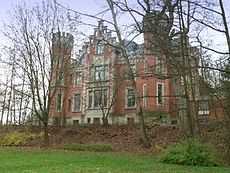
The neo-Gothic Schloss Ketschendorf is located in Ketschendorf, at the foot of the Buchberg, in the district of Coburg, in the state of Bavaria, in Germany.
Built at the beginning of the 19th Century, the residence of the Baroness von Stolzenau was surrounded by a large park. The castle is counted as one of the jewels of the Neugotischen Gürtels [“Gothic Revival Belt”] of Coburg and had nine different owners throughout its history. Since 1956 it had been used as a youth hostel, which was closed on 1 December 2010 until further notice because of the planned renovate.
History
Original Building
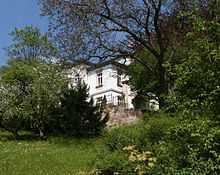
Keczendorff, as Ketschendorf was first known around 900 years ago, was a defenseless village outside the city walls of Coburg was on the western slope of the Buchberg [“Book Mountain”]. The few inhabitants suffered greatly under the Hussite invasions in 1430 and the horrors of the German Peasants' War in 1525. Twice, in 1567 and 1626, the plague went through the town. In 1632, during the siege of the Veste Coburg, General Wallenstein moved, with extensive demands, his personal quarters to Ketschendorf and only two years later the Imperial Colonel Schlitz destroyed the whole place with his Croats. A good 150 years passed, allowing Ketschendorf to overcome most of the consequences of this disaster, but it was not until 1804, when the Duchess Augusta, wife of Francis, Duke of Saxe-Coburg-Saalfeld, built a summer palace in the Empire style as the first noble seat of the ancient village, an economic boom began.
After the death of the Duke in 1806, the Ketschendorf castle remained in the property of the widow Augusta. Besides her seven children, many princes came to visit with the Duchess. They were her sons-in-law, Duke Alexander of Württemberg, Grand Duke Constantine Pavlovich of Russia and Queen Victoria’s father, Prince Edward, Duke of Kent and Strathearn. Even Frederick Louis, Hereditary Prince of Mecklenburg-Schwerin, and the parents of Constantine, Paul I and Sophie Dorothea of Württemberg, as well as his brother, Tsar Alexander I of Russia, were guests at the castle.
In 1831, after the death of the Dowager Duchess Augusta, Duchess Marie of Württemberg, the second wife of Ernest I, moved to the Schloss Ketschendorf and lived there until she herself died in 1860. The owner of the property was then Duke Ernst II. In 1868, he sold the building to the supposedly ailing Frenchwoman named Victorine Noël.
Rosine Stoltz
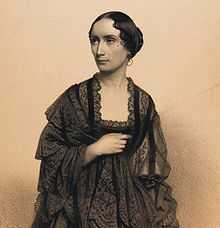
Born in Paris in 1815, Victorine Noël had already been, for the last 22 years, a celebrated opera singer with the stage name of Rosine Stoltz, a celebrated opera singer. She sang at the Theatre de la Monnaie in Brussels, the Paris Opera, the Teatro Municipal in Rio de Janeiro and the famous La Scala in Milan. The composers, Giacomo Meyerbeer and Gaetano Donizetti, wrote the roles specially for her. She enjoyed, in spite of her notoriety as an eccentric liar and schemer, the highest recognition in the professional circles and aristocratic audiences.
The then reigning Duke of Saxe Coburg and Gotha, Ernest II, was not only a friend of artists and singers, but also a composer of the opera, Santa Chiara [Italian, “Saint Clare”]. The main role in this romantic work was sang by Rosine Stoltz in 1856 at the Brussels Opera. Here he finally came to know the scandalous diva. They developed an intimate relationship, with Rosine Stoltz more often and also longer as a guest of the Duke of Saxe-Coburg in Gotha without ever appearing in the court theaters in Gotha and Coburg.
Ernest II eventually raised her to the peerage in 1865. She could then be addressed as the Freifrau [Baroness] von Stolzenau and, since 1868, the Baroness von Ketschendorf. After 1865, she fulfilled only one guest commitment, at La Scala in Milan, Italy, and never again appeared in the public as a singer.
Her great wealth enabled the freshly ennobled Baroness to acquire Schloss Ketschendorf with the adjoining park grounds for 100,000 francs, allegedly for her illegitimate son Charles, whose father, according to the Baroness, was supposed to be none other than Napoleon Bonaparte and who could now call himself as Karl Freiherr [Baron] von Ketschendorf. His real sire, Ernest II, was said to have openly boasted to have been virile (keinesfalls kinderlos = “not childless”) outside his own marriage.
Construction of the New Castle
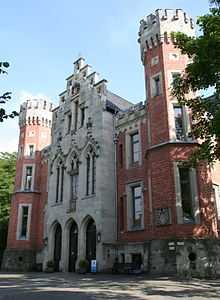
Already in 1868 the Baroness von Ketschendorf commissioned an architect from the Coburg, Georg Konrad Rothbart,[1] who created the Edinburgh Palais[2] in Coburg two years before, for the renovation of the ducal Empire-style manor. Rothbart, however, created a new castle, bigger and stronger, next to the original building and condemned the first building, only 63 years old, to be demolished because its “surrounding walls were, for the most part, totally rotten”. Within less than a year, he achieved, with the use of 70 craftsmen, the construction, which could be continued, with the masons available at a workshop in the hall of the old castle, through the harsh winter of the year. In June 1869, the new Schloss Ketschendorf was finished and the old one was removed. The demolition material was used to build in the Oberen Klinge [Upper Lawn] No. 3 in Coburg a villa, which quite accurately reproduced the appearance of the old Schloss Ketschendorf in every way and by using the original porches with its classical columns from the old Schloss. This villa is therefore also called the Altes Ketschendorfer Schloss [“Old Ketschendorf Castle”].
The new castle, with an almost square ground plan, was built from sandstone and red brick as a textbook example of neo-Gothic castle style of historicism in the Coburger Land. All four sides are flanked by octagonal crenellated towers. Each of the sides has in the centre a gable of tracery protruding from the top of the porch. The porch on the south side, designed as the entrance to the park, is particularly complicated. Above the gate, a loggia with an overlying terrace leads from the bedroom of the Baroness. The porch’s columns on the north front entrance copy the central projection of the south side in a simpler way. To the northwest corner tower, the building owner was allowed to attach her new family crest, carved in sandstone. The shield of the coat of arms shows a harp and a helmet with a baron's coronet and two folded wings. The motto underneath reads Vis in Corde (Latin, “Power in the heart”). In the gable, the arms of the later owner Baron von Mayer can be seen. It is split to show a rampant lion on the left side and three ears of corn on the right side, above which is a Spangenhelm [combat helmet from the Middle Ages] whose crown sprouts a rampant lion. The motto underneath reads: Fortes Fortuna Adjuval [Latin, “Fortune favors the brave”].
Inside the building the staircase was formed with decorative cast-iron railings and the view, with the tracery of the cathedral windows, is representative of the south side of the castle’s centre. Stuccoed ceilings in almost every room and a finely paneled Great Music Room reflect the personal tastes of the new chatelaine. Also, a dumbwaiter was installed between the kitchen and the overlying hall, as a matter of great importance.
After only two years, in 1871, the Baroness von Ketschendorf resold the whole property for only 90,000 francs and moved back to Paris to devote herself to the charitable services. At her death in 1903 she had not a centime left, and was buried at the expense of the overseers of the poor in Paris in a common pauper's grave. The new owner of the castle was, for a few months, a municipal architect from Coburg, Julius Martinet,[3] known as an architect of the Luther and Rückert School.
In 1872 the American William Tilden acquired the property and sold it in 1873 to the Kommerzienrat [Commercial Counsellor] Karl Rudolf Epner from Berlin. 1n 1891 the Jewish Freiherr von Mayer continued his speculation in real estate to an end and bought the castle and park as a family residence. In 1893 a staircase was created for the castle by Johannes Koehler with a tracery balustrade as an access to the park. In 1940 it came under the Nazi administration of the district through foreclosure because of the alleged debt of 145,000 Reichmarks in Reich Flight Taxes and the expulsion of the family of Mayer. The City of Coburg auctioned, for 45,000 Reichmarks, the Schloss Ketschendorf, including the park and furnishings, and set up a shelter for German repatriates from Bessarabia. From 1942 to the end of the war, the castle was used as a branch of the main hospital for the Coburger trade school, then until 1955 as the tuberculosis ward of the State Hospital.
The family property was returned in 1954 to Egon Freiherr von Mayer was the family property by the way of Wiedergutmachung [reparation] but he did not move back to Ketschendorf again. He sold it in 1955 to the city of Coburg which has been operating since 1956 the property as a youth hostel in the DJH-Landesverband Bayern e. V.[4] [Bavarian State Association of the German Youth Hostel Association]. On 1 January 1990, the sponsorship of the architectural preservation, construction and renovation of the castle, which began in 1979, was passed to the DJH-Landesverband but a part of the historic park, equipped with areas for games, sports, meadows and ponds, remained with the city.
Park
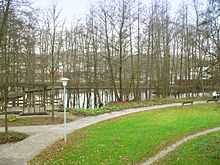
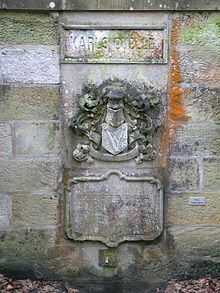
The castle’s park, now open to the public, was greatly expanded in 1868 at the construction of the new Schloss with some newly acquired land. In this way, the municipal well, important to the water supply of the households of Ketschendorf, was included. The old source now feeds the castle’s pond, which is located in the middle of the park. As a replacement for the no longer accessible community fountain, the Baroness donated the Karlsquelle [Karl’s Spring], named after her son, to the Wassergasse [water alley], next to the former forge. This pretty plant bears in sandstone the Stolzenau-Ketschendorf coat-of-arms and an inscription panel. This well was moved from there after 1974, after the opening of the park to the public.
At the edge of the castle’s pond stood the massive greenhouse, which belonged to the park. In the postwar years, it was abandoned to disrepair. It was eventually sold in 1959 to the Sportverein [Sports Club] Ketschendorf, which converted it to a training hall for weightlifting and a clubhouse and in 1995 added to the club a large open terrace at the lake.
Current Use
Since 1956, the romantic Schloss Ketschendorf has been used as a youth hostel (130 beds until 1979). The historic equipment in the entrance’s stairwell (stucco lustro) and in the Music Room (wall panels) still exist in some parts but, in all parts, the representative rooms of the main floor (piano nobile) still have the magnificent, color combined stucco and painted ceilings as well as overdoors. In 1960, the balconies and pillars were demolished at the entrance of the north front because of the disrepair. In 1979 and 1980, the present monument was built east of here. In addition, two new guest floors with 88 beds were made for the guest quarters, a manager’s apartment and a technical centre. Today, because of increased demand, the complex was expanded to about 130 available beds for the visitors. The timing of the implementation of plans for a 7.1 million-euro (USD 10,246,101) renovation, including the redevelopment of the youth hostel, was not foreseeable in 2011 because of the unresolved problems with the financing.
The Altes Ketschendorfer Schloss, the villa in the Oberen Klinge, received two awards in 2005 for its exemplary and detailed efforts of preservation during its expansion.
The former greenhouse at the castle’s pond, converted to a gymnasium, was commissioned in 1996 as the property of the city. Around 2002, the Seemanns-Chor [“Sailors Choir”] of Coburg acquired the offices of the building and kept them ever since as its local club, the Kajüte [“Cabin”]. The choir regularly hosts summer concerts in the park.
For the last few years, the Radwanderweg [Cycling Path] Coburg-Bamberg has been weaving through the park.
References
- ↑ (de) “Georg Konrad Rothbart”, Wikipedia: Die frei Enzyklopädie
- ↑ (de) “Edinburgh-Palais”, Wikipedia: Die frei Enzyklopädie
- ↑ (de) “Julius Martinet”, Wikipedia: Die frei Enzyklopädie
- ↑ (de) Deutsches Jugendherbergswerk German Youth Hostel Association, Wikipedia: Die frei Enzyklopädie
Bibliography
- (de) Dr. Fritz Mahnke, Schlösser und Burgen im Umkreis der Fränkischen Krone [Castles and Palaces in the Land of the Frankish Crown] (Coburg: Druck- und Verlagsanstalt Neue Presse GmbH, 1974), pp. 25–30
- (de) Otto Friedrich, Hundert Jahre Schloß Ketschendorf [Hundred Years of Schloss Ketschendorf](1970) and 900 Jahre Ketschendorf [900 Years of Ketschendorf] (1975)
- (fr) Arthur Pougin, “La Stoltz”, L'intermédiaire des chercheurs curieux [The Intermediary of the Curious Scholars], No. 1208, Vol. LIX (1909)
- (de) Renate Reuther, Villen in Coburg [Villas in Coburg] (Coburg: Veste Verlag Roßteuscher, 2011), pp. 97–106. ISBN 978-3-925431-31-9
External links
- (fr) Biography of Rosine Stoltz by the Société d'Histoire du Vésinet [Historical Society of the Vésinet]
- (de) Jugendherberge Coburg [Youth Hostel of Coburg]
Coordinates: 50°14′35″N 10°58′28″E / 50.24306°N 10.97444°E